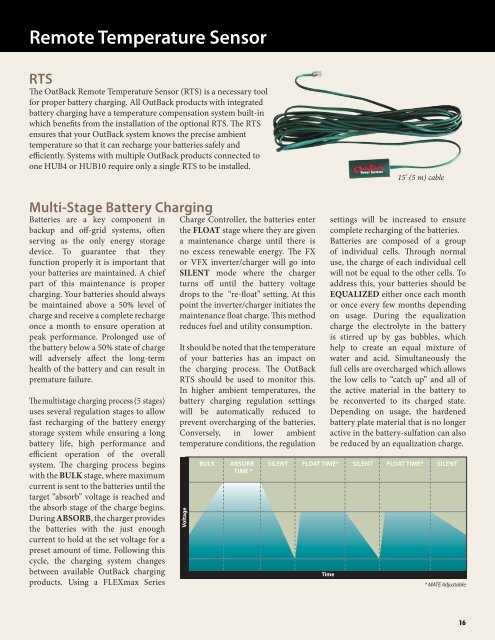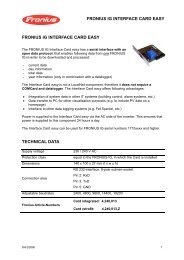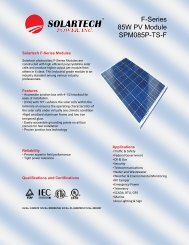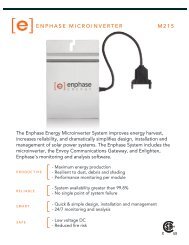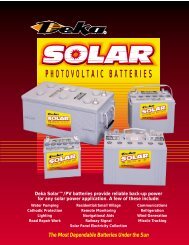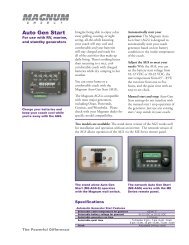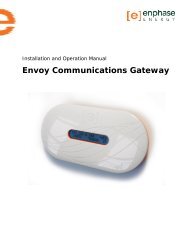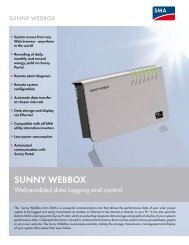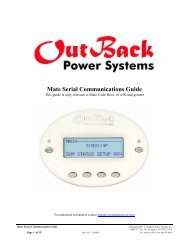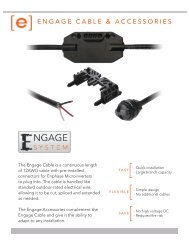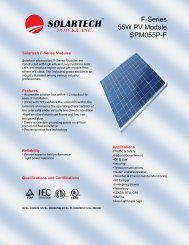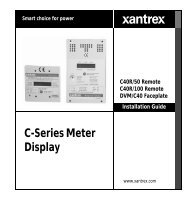To Download The Complete 2009 OutBack Power Systems Catalog
To Download The Complete 2009 OutBack Power Systems Catalog
To Download The Complete 2009 OutBack Power Systems Catalog
You also want an ePaper? Increase the reach of your titles
YUMPU automatically turns print PDFs into web optimized ePapers that Google loves.
Remote Temperature Sensor<br />
RTS<br />
<strong>The</strong> <strong>OutBack</strong> Remote Temperature Sensor (RTS) is a necessary tool<br />
for proper battery charging. All <strong>OutBack</strong> products with integrated<br />
battery charging have a temperature compensation system built-in<br />
which benefits from the installation of the optional RTS. <strong>The</strong> RTS<br />
ensures that your <strong>OutBack</strong> system knows the precise ambient<br />
temperature so that it can recharge your batteries safely and<br />
efficiently. <strong>Systems</strong> with multiple <strong>OutBack</strong> products connected to<br />
one HUB4 or HUB10 require only a single RTS to be installed.<br />
15' (5 m) cable<br />
Multi-Stage Battery Charging<br />
Batteries are a key component in<br />
backup and off-grid systems, often<br />
serving as the only energy storage<br />
device. <strong>To</strong> guarantee that they<br />
function properly it is important that<br />
your batteries are maintained. A chief<br />
part of this maintenance is proper<br />
charging. Your batteries should always<br />
be maintained above a 50% level of<br />
charge and receive a complete recharge<br />
once a month to ensure operation at<br />
peak performance. Prolonged use of<br />
the battery below a 50% state of charge<br />
will adversely affect the long-term<br />
health of the battery and can result in<br />
premature failure.<br />
<strong>The</strong> multistage charging process (5 stages)<br />
uses several regulation stages to allow<br />
fast recharging of the battery energy<br />
storage system while ensuring a long<br />
battery life, high performance and<br />
efficient operation of the overall<br />
system. <strong>The</strong> charging process begins<br />
with the BULK stage, where maximum<br />
current is sent to the batteries until the<br />
target “absorb” voltage is reached and<br />
the absorb stage of the charge begins.<br />
During ABSORB, the charger provides<br />
the batteries with the just enough<br />
current to hold at the set voltage for a<br />
preset amount of time. Following this<br />
cycle, the charging system changes<br />
between available <strong>OutBack</strong> charging<br />
products. Using a FLEXmax Series<br />
Charge Controller, the batteries enter<br />
the FLOAT stage where they are given<br />
a maintenance charge until there is<br />
no excess renewable energy. <strong>The</strong> FX<br />
or VFX inverter/charger will go into<br />
SILENT mode where the charger<br />
turns off until the battery voltage<br />
drops to the “re-float” setting. At this<br />
point the inverter/charger initiates the<br />
maintenance float charge. This method<br />
reduces fuel and utility consumption.<br />
It should be noted that the temperature<br />
of your batteries has an impact on<br />
the charging process. <strong>The</strong> <strong>OutBack</strong><br />
RTS should be used to monitor this.<br />
In higher ambient temperatures, the<br />
battery charging regulation settings<br />
will be automatically reduced to<br />
prevent overcharging of the batteries.<br />
Conversely, in lower ambient<br />
temperature conditions, the regulation<br />
Voltage<br />
BULK ABSORB SILENT FLOAT TIME* SILENT FLOAT TIME* SILENT<br />
TIME *<br />
Time<br />
settings will be increased to ensure<br />
complete recharging of the batteries.<br />
Batteries are composed of a group<br />
of individual cells. Through normal<br />
use, the charge of each individual cell<br />
will not be equal to the other cells. <strong>To</strong><br />
address this, your batteries should be<br />
EQUALIZED either once each month<br />
or once every few months depending<br />
on usage. During the equalization<br />
charge the electrolyte in the battery<br />
is stirred up by gas bubbles, which<br />
help to create an equal mixture of<br />
water and acid. Simultaneously the<br />
full cells are overcharged which allows<br />
the low cells to “catch up” and all of<br />
the active material in the battery to<br />
be reconverted to its charged state.<br />
Depending on usage, the hardened<br />
battery plate material that is no longer<br />
active in the battery-sulfation can also<br />
be reduced by an equalization charge.<br />
* MATE Adjustable<br />
16


